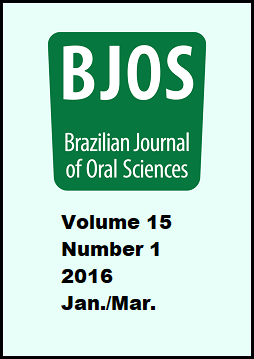Abstract
Aim: To analyze the root canal organic tissue dissolution capacity promoted by irrigating solutions, with or without the use of different agitation techniques. Methods: Bovine pulp tissue fragments were initially weighed. The following irrigating solutions were tested: 2.5% sodium hypochlorite, 2% chlorhexidine digluconate solution, and distilled water. The irrigating protocols were: immersion, mechanical agitation with endodontic files, and ultrasonic or sonic systems (Endoactivactor® and Easy Clean®). At the end of the protocols, the pulps were weighed to determine their final weight. For comparison, the average percentage of tissue dissolution in relation to the groups was analyzed using the Kruskal-Wallis nonparametric test complemented by multiple comparisons test. The significance level was set at 5%. Results: Among the irrigation solutions, 2.5% sodium hypochlorite showed a higher dissolving power than 2% chlorhexidine digluconate and distilled water. Furthermore, ultrasonic and sonic systems were more effective irrigating protocols than immersion and mechanical agitation with endodontic files. Conclusions: The combination of sodium hypochlorite with an agitation system promotes a greater degree of tissue degradation.
References
Peters OA, Laib A, Göhring TN, Barbakow F. Changes in root canal geometry after preparation assessed by high resolution computed tomography. J Endod. 2001 Jan;27(1):1-6.
Vera J, Siqueira JF Jr, Ricucci D, Loghin S, Fernández N, Flores B, et al. One- versus two-visit endodontic treatment of teeth with apical periodontitis: a histobacteriologic study. J Endod. 2012 Aug;38(8):1040-52. doi: 10.1016/j.joen.2012.04.010.
Giardino L, Estrela C, Mohammadi Z, Palazzi F. Antibacterial power of sodium hypochlorite combined with surfactants and acetic acid. Braz Dent J. 2014;25(4):289-94.
Tartari T, Guimarães BM, Amoras LS, Duarte MA, Silva e Souza PA, Bramante CM. Etidronate causes minimal changes in the ability of sodium hypochlorite to dissolve organic matter. Int Endod J. 2015 Apr;48(4):399-404. doi: 10.1111/iej.12329.
Mirhadi H, Abbaszadegan A, Ranjbar MA, Azar MR, Geramizadeh B, Torabi S, et al. Antibacterial and Toxic Effect of Hydrogen Peroxide Combined with Different Concentrations of Chlorhexidine in Comparison with Sodium Hypochlorite. J Dent (Shiraz). 2015 Dec;16(4):349-55.
Gomes BP, Vianna ME, Zaia AA, Almeida JF, Souza-Filho FJ, Ferraz CC. Chlorhexidine in endodontics. Braz Dent J. 2013;24(2):89-102. doi: 10.1590/0103-6440201302188.
Clarkson RM, Moule AJ, Podlich H, Kellaway R, Macfarlane R, Lewis D, et al. Dissolution of porcine incisor pulps in sodium hypochlorite solutions of varying compositions andconcentrations. Aust Dent J. 2006 Sep;51(3):245-51.
Del Carpio-Perochena AE, Bramante CM, Duarte MA, Cavenago BC, Villas-Boas MH, Graeff MS, et al. Biofilm dissolution and cleaning ability of different irrigant solutions on intraorally infected dentin. J Endod. 2011 Aug;37(8):1134-8. doi: 10.1016/j.joen.2011.04.013.
Andersen M, Lund A, Andreasen JO, Andreasen FM. In vitro solubility of human pulp tissue in calcium hydroxide and sodium hypochlorite. Endod Dent Traumatol. 1992 Jun;8(3):104-8.
Cobankara FK, Ozkan HB, Terlemez A. Comparison of organic tissue dissolution capacities of sodium hypochlorite and chlorine dioxide. J Endod. 2010 Feb;36(2):272-4. doi: 10.1016/j.joen.2009.10.027.
Stojicic S, Zivkovic S, Qian W, Zhang H, Haapasalo M. Tissue dissolution by sodium hypochlorite: effect of concentration, temperature, agitation, and surfactant. J Endod. 2010 Sep;36(9):1558-62. doi: 10.1016/j.joen.2010.06.021.
Taneja S, Mishra N, Malik S. Comparative evaluation of human pulp tissue dissolution by different concentrations of chlorine dioxide, calcium hypochlorite and sodium hypochlorite: An in vitro study. J Conserv Dent. 2014 Nov;17(6):541-5. doi: 10.4103/0972-0707.144590.
Irala LED, Soares RG, Salles AA, Munari AZ, Pereira JS. Dissolution of bovine pulp tissue in solutions consisting of varying NaOCl concentrations and combined with EDTA. Braz Oral Res. 2010 Jul-Sep;24(3):271-6.
Só MVR, Cemim A, Pereira EP, Irala LED. Tissue dissolution ability of sodium hypochlorite from different manufacturers. Braz Endod J. 2010 Sep;36(9):1558-62. doi: 10.1016/j.joen.2010.06.021.
Niewierowski RS, Scalzilli LR, Morgental RD, Figueiredo JA, Vier-Pelisser FV, Borba MG, et al. Bovine pulp tissue dissolution ability of irrigants associated or not to ultrasonic agitation. Braz Dent J. 2015 Oct;26(5):537-40. doi: 10.1590/0103-6440201300243.
Morgan RW, Carnes DL Jr, Montgomery S. The solvent effects of calcium hydroxide irrigating solution on bovine pulp tissue. J Endod. 1991 Apr;17(4):165-8.
Slutzky-Goldberg I, Hanut A, Matalon S, Baev V, Slutzky H. The effect of dentin on the pulp tissue dissolution capacity of sodium hypochlorite and calcium hydroxide. J Endod. 2013 Aug;39(8):980-3. doi: 10.1016/j.joen.2013.04.040.
Arslan D, Guneser MB, Kustarci A, Er K, Siso SH. Pulp tissue dissolution capacity of QMix 2in1 irrigation solution. Eur J Dent. 2015 Jul-Sep;9(3):423-7. doi: 10.4103/1305-7456.163229.
Johnson BR, Remeikis NA. Effective shelf-life of prepared sodium hypochlorite solution. J Endod. 1993 Jan;19(1):40-3.
Gordon TM, Damato D, Christner P. Solvent effect of various dilutions of sodium hypochlorite on vital and necrotic tissue. J Endod. 1981 Oct;7(10):466-9.
Estrela C, Estrela CR, Barbin EL, Spanó JC, Marchesan MA, Pécora JD. Mechanism of action of sodium hypochlorite. Braz Dent J. 2002;13(2):113-7.
Okino LA, Siqueira EL, Santos M, Bombana AC, Figueiredo JAP. Dissolution of pulp tissue by aqueous solution of chlorhexidine digluconate and chlorhexidine digluconate gel. Int Endod J. 2004 Jan;37(1):38-41.
Marley JT, Ferguson DB, Hartwell GR. Effects of chlorhexidine gluconate as an endodontic irrigant on the apical seal: short-term results. J Endod. 2001 Dec;27(12):775-8.
Sabins RA, Johnson JD, Hellstein JW. A comparison of the cleaning efficacy of short term sonic and ultrasonic passive irrigation after hand instrumentation in molar root canals. J Endod. 2003 Oct;29(10):674-8.
Paragliola R, Franco V, Fabiani C, Mazzoni A, Nato F, Tay FR, et al. Final rinse optimization: influence of different agitation protocols. J Endod. 2010 Feb;36(2):282-5. doi: 10.1016/j.joen.2009.10.004.
Haapasalo M, Wang Z, Shen Y, Curtis A, Patel P, Khakpour M. Tissue dissolution by a novel multisonic ultracleaning system and sodium hypochlorite. J Endod. 2014 Aug;40(8):1178-81. doi: 10.1016/j.joen.2013.12.029.
The Brazilian Journal of Oral Sciences uses the Creative Commons license (CC), thus preserving the integrity of the articles in an open access environment.

